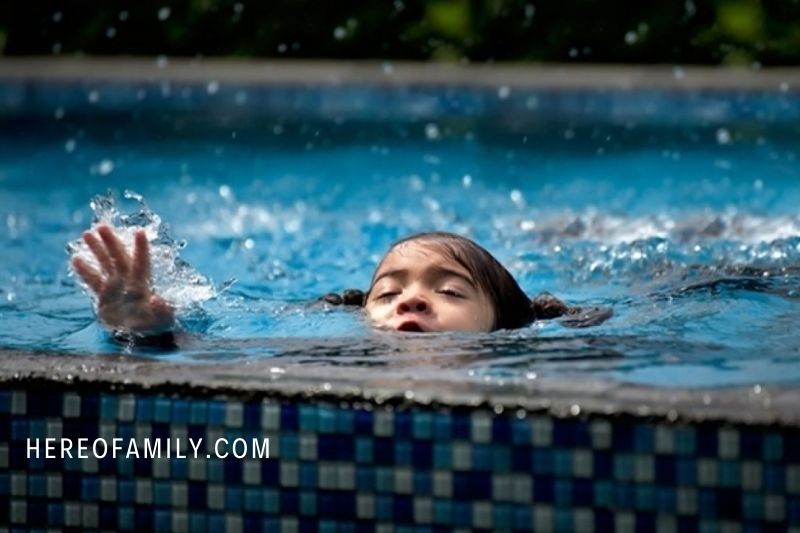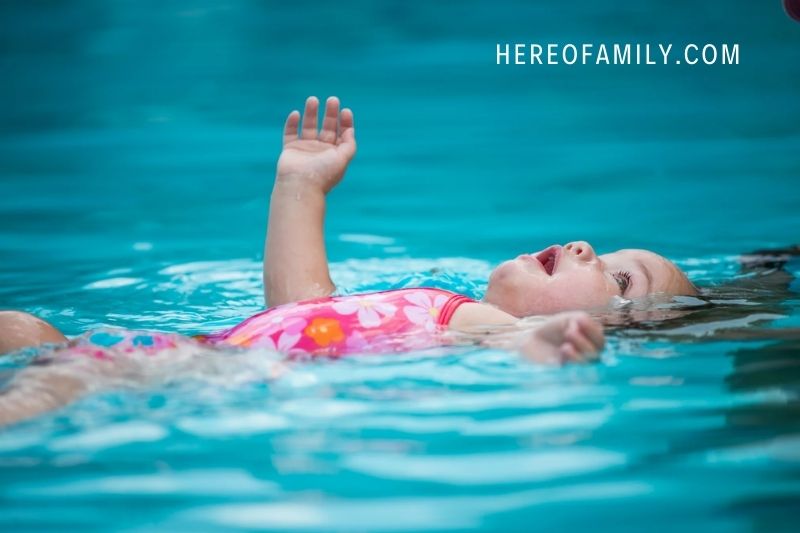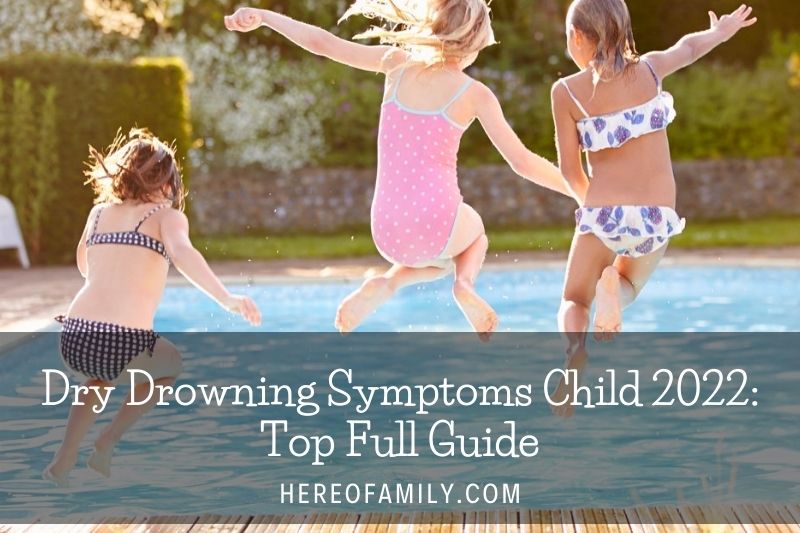It is important to be aware of the symptoms of dry drowning in children, as it can be a serious and potentially fatal condition. Dry drowning symptoms child include coughing, chest pain, difficulty breathing, and lethargy. If your child exhibits these symptoms after being in the water, it is important to seek medical attention immediately.
Contents
What Is ‘Dry Drowning’?

When your children are swimming or playing in the pool or splashing in the ocean, you pay careful attention to them. You make certain that a lifeguard is there, and you never leave your children alone near any body of water, even the bathtub. That is the correct course of action.
But there’s still something you can do to keep them safe: learn how to recognize danger after they’ve exited the water and what to do about it.
Medical professionals define drowning as having difficulty breathing after getting water into your airways. This might happen when swimming or bathing. However, it may occur due to anything as simple as getting water in your mouth or submerged.
It can be lethal, but it isn’t always. If you obtain aid quickly away, you can survive drowning.
You’ve probably heard “dry drowning” and “secondary drowning” before. Those aren’t medical words at all. However, they allude to unusual issues that you should be aware of and more likely in youngsters.
Water never enters the lungs in the case of so-called dry drowning. On the other hand, breathing in water causes your child’s vocal cords to spasm and lock up. This closes down their airways, making it difficult for them to breathe. You’d see such signals immediately. They wouldn’t appear anywhere days later.
Another name for another kind of drowning complication is “secondary drowning.” It occurs when water enters the lungs. It may irritate the lining of the lungs and cause fluid to build up, resulting in pulmonary edema. You’d most certainly notice your kid having difficulty breathing straight soon, and it might worsen over the following 24 hours.
How Is Common Dry Drowning?

Submersion injuries, although terrifying, are quite uncommon. According to Kathleen Berchelmann, M.D., a pediatrician at St. Louis Children’s Hospital and Washington University School of Medicine, there are no clear statistics on how many children die from dry drowning or secondary drowning each year.
In fact, in his 12 years of practice as a pediatrician, Dr. Berchelmann has only encountered one patient who drowned after getting out of the pool. Still, she adds, it was a potentially fatal circumstance, and if you’re going to be spending time in a pool, ocean, or lake this summer, it’s a good idea to be aware of the warning signs and symptoms.
Dry Drowning Symptoms Child
“You’re going to notice warning symptoms,” says Sarah Denny, M.D., an attending physician in the Section of Emergency Medicine at Nationwide Children’s Hospital in Columbus, Ohio, and a member of the American Academy of Pediatrics Council Injury, Violence, and Poison Prevention.
Keep an eye out for the following dry drowning signs in toddlers, infants, and children:
Rescue from the water. “Any youngster dragged from the water requires urgent treatment,” Dr. Berchelmann warns. “At the absolute least, get in touch with a pediatrician.”
Increased “breathing work.” Rapid and shallow breathing or nostril-flaring, according to Dr. Denny, indicates that your kid is working more to breathe than usual—as does seeing the space between the child’s ribs or the gap above their collarbone when they breathe. If you observe any of these symptoms, you should seek medical attention.
Coughing. Coughing that persists or is coupled with greater breathing labor should be investigated.
Sleepiness. Was your child playing in the water, and now they’re behaving tired? It’s possible they’re not receiving enough oxygen in their blood. Please don’t put them to bed until their doctor says it’s okay.
Forgetfulness or a shift in conduct Similarly, a drop in oxygen levels may cause your youngster to feel ill or wobbly.
I’m puking. “Vomiting is a symptom of stress from the body due to the inflammation and occasionally a shortage of oxygen and chronic coughing and choking,” Dr. Berchelmann adds.
Contact your physician if you suspect your kid has suffered a submersion injury, whether in your home pool or on a beach trip. According to Dr. Berchelmann, they should walk you through your symptoms and may encourage you to go to the ER, a primary care doctor, or a national urgent care center.
However, if your kid has trouble breathing, contact 911 and go to the emergency hospital immediately. “Necessary care may be unavailable in places other than the ER,” Dr. Zonfrillo explains.
Treatment For Dry Drowning
If you see signs of dry drowning, you should seek immediate medical attention. Call 911 right away.
Meanwhile, strive to maintain your or your child’s quiet during the laryngospasm. Keeping calm might aid in the relaxation of the windpipe muscles.
When emergency personnel comes, they will treat the patient on the spot. If someone has passed out owing to a lack of oxygen, resuscitation may be required.
When the patient is stabilized, they will be brought to the hospital for observation. Dry drowning symptoms following a submersion occurrence need medical attention to ensure normal breathing returns and rule out additional illnesses such as subsequent drowning or bacterial pneumonia. To rule out water in the lungs, a chest X-ray or assessment by a pulmonary expert may be required.
How to Prevent Dry Drowning
Consider these expert-approved measures to avoid dry drowning and secondary drowning, and other water-related ailments.
Enroll your youngster in swimming classes. Children who can manage the water with ease are less likely to struggle.
Keep an eye on children who are near water. When children are near water, keep a tight eye on them. Also, make sure that pool safety law are followed.
Adhere to water safety precautions. On boats, children should have flotation devices. Pools should have four-sided fencing and never leave a youngster alone near standing water.
You shouldn’t be concerned about dry or secondary drowning as long as you practice water safety, pay careful attention to your children after swimming, and check them out if they have difficulties breathing (submersion injuries). “I can’t underscore how unusual these are enough,” Dr. Zonfrillo adds. And we all know that’s great news for any parent.
Some relevant posts:
- Does Baby Powder Cause Cancer? Complete Guide 2023
- Best Baby Breathing Monitor: Keep Baby Safe and Sound 2023
- Is Wifi Safe For Babies? Top Full Guide 2023
- How To Help Choking Baby? Top Full Guide [2022]
- Check Neighborhood Safety 2023: Top Full Guide
- Is Daycare Safe For Infants 2023? Top Full Options Here!
- Where To Put Baby Monitor? Top Full Guide [2022]
FAQ
How soon do symptoms of dry drowning occur?
Dry drowning symptoms appear immediately after a drowning episode, while secondary drowning symptoms appear 1-24 hours after water enters the lungs. Coughing, vomiting, fever, diarrhea, trouble breathing, chest discomfort, and tiredness are possible symptoms.
Can a baby dry drown from a bath?
“This may also happen in a bathtub if the youngster falls face down in the water.” That water may irritate the lungs, leading to even more fluid buildup. If too much liquid accumulates, the lungs may become too small to hold more air. It was formerly known as dry or secondary drowning, and some people still refer to it as such.
What happens if you inhale a little water?
Coughing can often eliminate a tiny quantity of water that has been inhaled into the lungs. When a large amount of water enters the lungs and is not removed, it may irritate the lining of the lungs and create fluid accumulation, a condition known as pulmonary edema.
Conclusion
Dry drowning occurs when a child inhales water through the nose or mouth and enters the lungs. The symptoms of dry drowning can be difficult to spot but may include coughing, chest pain, trouble breathing, and fatigue. If you think your child may be experiencing dry drowning, it is important to seek medical attention immediately.
